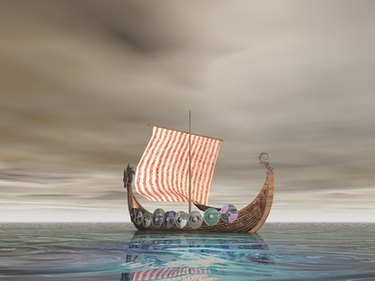Things You'll Need
Quart-size milk or juice carton
Ruler
Scissors
Brown paint and paintbrush
Cardboard
Glue
8 chopsticks
Brown construction paper
14-inch dowel
Red-and-white-striped fabric
White string
Air-drying clay (optional)

The Vikings were the most powerful people in northwestern Europe from the ninth through the 11th centuries. Powered by both sail and oars, Viking longships were ideally suited for raiding, since their build could navigate shallow waters like rivers and estuaries. The Vikings traveled from Norway east to the Black Sea and west, founding colonies in Iceland and Greenland. Viking coins and other artifacts have also been found in Labrador, Canada. Make a Viking longship model with a milk or juice carton.
Step 1
Study images of Viking longships to get an idea of the boat's shape. Both the front (prow) and back (stern) are vertically curved, the center of the boat is long and thin, and the single central mast features a wide red and white striped sail. Along each side will be four oars.
Video of the Day
Step 2
Empty and wash the milk or juice carton. Glue the drinking flaps closed. Lay it down on its long end. Measure halfway up each long side, and draw a line all the way around the sides of the carton. Cut the carton in half lengthwise. Paint both the inside and outside of the carton brown and let the paint dry.
Step 3
Cut two matching curved shapes out of cardboard for the prow. The Vikings sometimes had dragons for figureheads. Paint the figurehead brown. Glue to the front of the milk carton over the drinking flaps to form the longship shape. Cut two matching curved shapes out of cardboard for the stern. Paint brown and let dry. Glue to the back of the milk carton to complete the longship shape.
Step 4
Paint the eight chopsticks brown and let dry. Cut eight small ovals out of brown construction paper for the oar paddles, and glue one to the end of each chopstick. Let the glue dry. Poke four holes into each side of the milk carton longship and push the oars through.
Step 5
Paint the dowel brown and let dry. This is the longship mast. Glue it to the center of the longship. Hold it in place with a small bit of air-drying clay.
Step 6
Stiffen the square of red and white striped fabric with glue, and place glue on the sides to prevent fraying. Cut a small hole in the fabric about 1 inch up from the bottom, right in the center. Cut a second hole in the fabric at the other end. Slide the dowel mast through the fabric holes, so that part of the mast sticks out at the top. Add a dab of glue where the sail meets the mast, to hold it in place and keep it from sliding.
Step 7
Tie one piece of white string to the left corner of the fabric sail and glue the other end of the string to the base of the mast. Tie a second piece of string to the right corner of the sail and glue the other end to the base of the mast. This is the ship's rigging.
Tip
If you want it to float, paint the body of the ship and the prow and stern with waterproof varnish.
Warning
This model is not precise. This model has a flat bottom, whereas real Viking longships had a pointed bottom.
Video of the Day